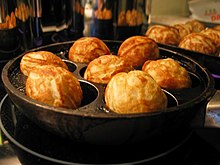Æbleskiver
Æbleskiver (literally translated: apple slices ) are a traditional Danish pastry that is baked especially during Advent and Christmas . Æbleskiver are fried in fat in a special pan with hemispherical recesses on the stove (Danish: Æbleskivepande ). The pastry is also common in Norway under the name Munker . In English-speaking countries, the spelling Ebelskiver (s) can also be found . The Æbleskiver are related to the Pförtchen (also futjes ) and donuts that are common in Germany , but are usually not baked with yeast dough.
Traditionally, Æbleskiver are prepared with buttermilk , grated lemon and sometimes with cardamom . The pastries are now also available in numerous variations and modifications, with different fillings and additions. In Sønderjylland, for example, there is the variant with yeast and plum purée . Contrary to what the name suggests, Æbleskiver today usually do not contain any apple filling. The golden brown baked Æbleskiver are sprinkled with powdered sugar after baking and served with jam .
history
The origins of the Æbleskiver go back to the Middle Ages , when the last apples were sliced in winter, put in batter and fried in butter or oil as apple fritters. This is how the pastry got its current name. In the 17th century, the Æbleskivepans, which are usually made of cast iron , finally appeared . Back then, Æbleskiver were filled with apple slices or with apple sauce or other fruit sauce . In the country, the pastry developed into a typical holiday present for farm workers before Christmas. The Æbleskiver, as they are common today, were first described in the collection of poetry Peters Jul from 1866. In the fairy tale Der Krüppel (in Danish: Krøblingen ) by Hans Christian Andersen from 1872 there is talk of apple-filled Æbleskiver , which suggests that filling with apples was no longer a matter of course even then. The pastry is traditionally also in connection with the North German-Danish Heischebrauch of Rummelpott running ( rummelpot or rumlepotte ) New Year's Eve.
See also
literature
- Kevin Crafts: Æbleskiver , Nærum 2011, ISBN 9788779006225
- Erik Koed Westergaard: Danske Egnsretter , Lindhardt og Ringhof, Copenhagen 1974, ISBN 8775601524
Individual evidence
- ↑ Sønderjyske aebleskiver med Svesker. (No longer available online.) Æ Synnejysk Forening, archived from the original ; accessed on November 28, 2015 .
- ↑ I dag shall vi have æbleskiver. Danmarks Radio, accessed November 28, 2015 .
- ↑ bleskiver. Dansk Historisk Fællesråd, accessed November 28, 2015 .
- ↑ What are bleskivers? Skagen Journal, accessed November 28, 2015 .
- ↑ Hvorfor hedder det æbleskiver. (No longer available online.) Infostein.dk, archived from the original on March 4, 2016 ; accessed on November 28, 2015 . Info: The archive link was inserted automatically and has not yet been checked. Please check the original and archive link according to the instructions and then remove this notice.
- ↑ Rumlepotte. Gyldendals Store Danske, accessed November 28, 2015 .

